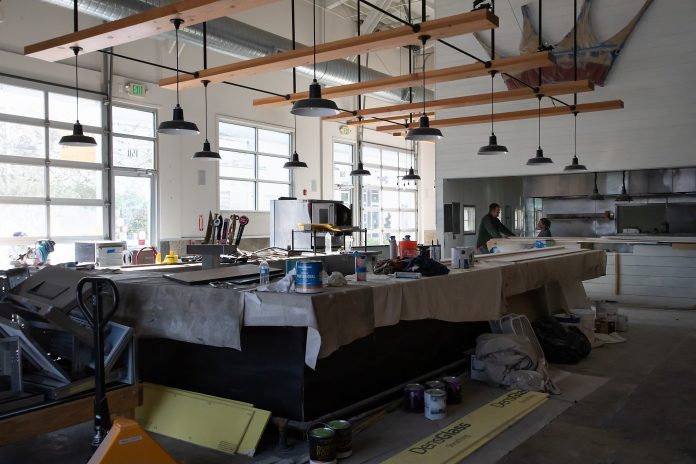For more stories like this, check out The Chronicle’s weekly Travel newsletter! Sign up here.
This winter, incessant rainstorms in the North Bay drove floodwaters into Sebastopol’s popular shopping district, the Barlow, inundating about a dozen stores and restaurants and causing panic among business owners.
Zazu Kitchen + Farm, arguably the most happening restaurant in the complex, was hit particularly hard. More than 2 feet of standing water damaged drywall and short-circuited electrical systems after the nearby Laguna de Santa Rosa wetlands overflowed in late February. Owners Duskie Estes and Jon Stewart had to scramble, summoning friends to help them move inventory and equipment to higher ground in a hurry.
The water receded about a week after days of rain caused the Russian River to jump its banks. But more than a month later, businesses are still reeling.
Zazu won’t reopen at the Barlow. On Thursday, trucks arrived at the restaurant to remove Zazu’s kitchen equipment.
“We can’t occupy the building,” Stewart told the Santa Rosa Press Democrat. “There’s just no way we can open. I mean if there’s no way to get to the bathroom, you’re not opening.”
Zazu isn’t alone. Entrepreneurs in Sebastopol and Guerneville are struggling to return to normalcy. Many face huge expenses, as very few had ponied up for costly flood insurance. It’s another damaging blow to tourism-dependent businesses still grappling with the devastation caused by the 2017 Wine Country fires.
“Mother Nature tested our mettle again, and we showed our resiliency and perseverance,” says Claudia Vecchio, president and CEO of Sonoma County Tourism.
County officials estimate the flooding caused $35 million of damage to businesses, about one-fifth of the estimated $155 million cost of the disaster overall. Now, business owners are hoping for a deluge of a different kind — one of tourists returning to the region.
Though the local tourism bureau has not released official statistics on monthly visits, local entrepreneurs say tourist traffic in business districts has dropped precipitously in the past two months — down 30 percent or more, in some cases. A rough count indicates about a dozen businesses in Sebastopol and Guerneville remain closed due to the damage.

Sebastopol
Perhaps no place took as much of a hit as the Barlow, a former apple processing factory converted to a 12-acre high-end retail development that opened in 2013.
The deluge swamped the east side of the shopping area, inundating the business spaces with 3 to 6 feet of standing water. Many business owners first explored the damage by kayak. The western half of the shopping district, which slopes slightly uphill, emerged virtually unscathed. Some businesses, such as Fern Bar and Spirit Works Distillery, sit on raised concrete pads and weren’t impacted at all.
Other businesses, however, didn’t fare as well. Village Bakery, for instance, sits at the lowest point, and its 3,500-square-foot production kitchen took on more than 5 feet of water. Owner Patrick Lum declared the facility a total loss. Adele Stoll, who owns an eponymous gallery of handcrafted handbags, jewelry and home decor, said the flood ruined all of her crafting goods and electronics. Another gallery owner said she lost a $100,000 painting.
Barrio Cocina Fresca, a Mexican street food vendor next to Village Bakery, also lost some equipment and inventory, but was able to reopen earlier this month. According to the Press Democrat, Village Bakery plans to return to the Barlow later this year.
As for Zazu, though Estes and Stewart had initially worked to repair the restaurant and hoped to reopen in May, they’ve decided to regroup and reopen elsewhere at a later date.
In the meantime Zazu has had to layoff its staff of 35, and the restaurant is holding pop-ups every weekend at Davis Family Vineyards in Healdsburg starting Memorial Day Weekend.
Most of the flooded businesses probably will be grappling with the effects of the damage well after they open their doors again. Very few had flood insurance; they say that it is prohibitively expensive and that the area hadn’t flooded in decades. What’s more, because the owners of the Barlow offered tenants flood-proof door barriers and the barriers didn’t work, business owners are considering legal action. (Barney Aldridge, owner of the Barlow, did not respond to calls for comment on this story.)

Guerneville
The riverfront city of Guerneville also was inundated this winter. Flood stage for the Russian River there is 32 feet, and the river crested at more than 45 feet.
Floodwaters covered the main thoroughfares in and out of the town, essentially turning Guerneville into an island, cut off from the rest of Sonoma County on all sides. Swift currents carried people away as they tried to escape. Television clips showed rescue crews getting around on boats powered by outboard motors. Water quickly overtook sandbag walls downtown.
Not the entire city was affected — just the parts closest to the Russian River. Still, county officials estimate the flooding damaged more than 3,000 structures overall. Most of those were homes.
At local businesses, floodwaters destroyed drywall, short-circuited servers and spoiled goods. Jerry Knight, owner of the River Theater, said sound equipment was ruined. Jilla Gauthier, owner of River Queen Clothing, said the floodwater warped her store’s floors.
It could have been much worse. While business owners at the Barlow were new to flooding, those in Guerneville are experienced veterans: The town has flooded 38 times since 1940, and just about everyone has some sort of emergency plan.
Before she evacuated, Gauthier took her merchandise and put it on racks high above the floor. Other business owners prepared by putting ovens, electrical equipment and other important items on pedestals or raised pads. “Most of us have experienced this before,” says Christa Luedtke, who owns Boon Hotel + Spa and a number of other businesses around town. “You learn tricks over the years to minimize the damage.”
After spending $20,000 to remediate damage to her pool after a flood in 2017, Luedtke tried a new approach this year: She filled the pool to the brim and covered it with a tarp. Though the property took on about 30 inches of water, the pool emerged unscathed.
Elsewhere around town, business owners shared similar stories. Even those who experienced losses were quick to pull out the damaged goods and line up repairs. Piles of debris lined River Road immediately after the flood; by mid-April, local refuse companies had removed much of it. Most of the businesses that had shuttered for repairs initially were open again by April 1. In fact, as a visitor to the region, if you didn’t know about the floods, you wouldn’t notice anything out of the ordinary.
To aid businesses still feeling the pinch, the Russian River Chamber of Commerce launched a marketing promotion in early April dubbed “Better Together.” Through this campaign, participating businesses are giving out customer discounts for sharing pictures of the region on social media with the hashtag #bettertogether.
At AutoCamp Russian River, for instance, a glamping destination that closed for much of March to repair damage, an Instagram post with the hashtag will net guests 5% off their next stay. At Big Bottom Market downtown, the hashtag will get you a free biscuit and drink.
“There isn’t a lot of money in the coffers right now,” said Michael Volpatt, who owns the market and is co-owner of Equality Vines across River Road. “We want to make sure people know Guerneville and the whole West County area has recovered and is ready for summer.”
Matt Villano is a freelance writer in Healdsburg. Email: [email protected]







































